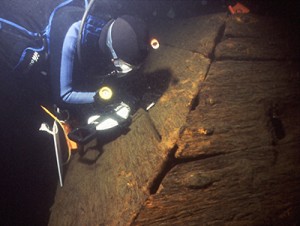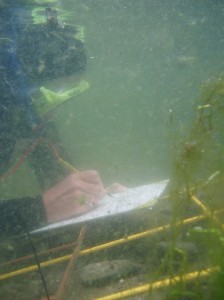Conducting archaeological research is a difficult process. Natural decay, catastrophic events, looters- all present challenges that must be navigated by the archaeologist. Now try doing it a hundred (or more) feet underwater.
Underwater archaeology is, as the name would suggest, archaeology practiced underwater, and it presents a whole new set of problems for archaeologists. For one, underwater sites like sunken ships are difficult to access, requiring experienced divers and diving equipment (and, in some cases, submarines). Tidal flows and poor weather may also render some sites inaccessible at certain times.
Secondly, divers have limited oxygen and cannot stay

Underwater archaeologist Joseph W. Zarzynski makes a measurement of the starboard view hold on the 1758 Land Tortoise radeau shipwreck, a British warship from the French & Indian War.
underwater for very long, making repeated dives necessary in order examine and record the entire site. Extensive planning and choreography of the dives beforehand, therefore, is of the utmost importance. Even when carefully planned out, recording an entire site can take many years, as in the case of the Land Tortoise Radeau.
Another challenge of underwater archaeology is the temperature of the water. Though they wear wetsuits (or drysuits in colder water) divers’ bodies will eventually get cold as they give off heat to the surrounding water. This, along with having fixed amounts of air, limits the amount of time that divers can spend observing and recording underwater sites.
Limited visibility can also present a huge problem for underwater archaeologists. Scale drawing and photography are both popular techniques when it comes to recording underwater sites, but poor water clarity distorts photographs and can make it difficult for divers to record their observations. However, the use of photoshop to combine photographs of the site taken at adjacent points has helped to overcome some issues of visibility underwater. The use of video cameras can also help provide a more accurate picture of the site.
After sorting through the many issues that arise during the planning and conducting of underwater archaeological research, archaeologists are faced with the difficult task of preserving underwater sites and artifacts. Conservation of underwater sites is both expensive and time consuming, but without proper care artifacts may deteriorate or be damaged accidentally by members of the public. In many cases, it is inconvenient or impossible to remove underwater artifacts, and archaeologists must work to ensure that the site is protected from looters and other sources of potential damage.
From start to finish, underwater archaeology is a mess of logistics problems, though
when conducted properly, it can yield amazing finds. A popular underwater site that immediately comes to mind is that of the RMS Titanic. The Titanic lies over 12,000 ft under water, making it extremely difficult to access and conserve, but many artifacts from the wreck have been recovered and used to educate the public about the lives of the ship’s passengers. In this way, despite its many challenges, underwater archaeology is a thrilling and rewarding sphere of archaeology that can teach us much about the people of the past, while simultaneously breaking down the ever-persistent Indiana Jones archaeologist stereotype.
Works Cited:
Image 1: http://www.themua.org/raisingthefleet/index.php?content=hist4
Image 2: http://en.wikipedia.org/wiki/File:Scale_drawing_underwater.jpg
Image 3: http://www.npr.org/blogs/thetwo-way/2011/12/29/144445117/titanic-artifacts-to-be-auctioned
Ashmore, Wendy, and Robert J. Sharer. “How Archaeology Works.” Discovering Our Past: A Brief Introduction to Archaeology. New York, NY: McGraw-Hill. 64. Print.
Cantelas, FJ; Rodgers, BA (1997). “Tools, Techniques, and Zero Visibility Archaeology.” In: EJ Maney, Jr and CH Ellis, Jr (Eds.) Diving for Science…1997. Proceedings of the American Academy of Underwater Sciences (17th Annual Scientific Diving Symposium).
Durrani, Nadia. “Underwater Archaeology: George Bass.” World Archaeology. 7 Nov. 2005. Web. <http://www.world-archaeology.com/features/underwater-archaeology-george-bass/>.
Hamilton, Donny L. “Basic Methods of Conserving Underwater Archaeological Material Culture.” Web. <http://www.history.navy.mil/branches/UA_%20Conserv.pdf>.
“The Challenge of Working Underwater.” Wisconsin Historical Society. Web. <http://www.wisconsinhistory.org/shipwrecks/learn/challenges.asp>.
“The Importance of Underwater Archaeology.” Wisconsin Historical Society. Web. <http://www.wisconsinhistory.org/shipwrecks/learn/importance.asp>.
“The Lost Radeau: A Shipwreck in Lake George.” All Over Albany. 5 Aug. 2009. Web. <http://alloveralbany.com/archive/2009/08/05/the-lost-radeau-a-shipwreck-in-lake-george>.



You do an excellent job of detailing the challenges faced by underwater archaeologists. Preservation of submerged artifacts, in particular, has been an interesting problem for many underwater researchers. For instance, the state of Florida, like Zarzynski’s research team, has opted to make its underwater heritage open to the public. Florida has opened a total of 11 ocean preserves since 1987 for divers, where they can visit historic submerged vessels all along the Gulf and Atlantic coasts; the preserves include the wreckage of huge steamers, historic yachts, and merchant ships. Though many of the ships might attract treasure hunters (the Urca de Lima, a Spanish treasure ship that sank in 1715, comes to mind), the artifacts of these ships have either all been retrieved or are protected by law. Despite the risks of disturbances to these ships, their educational and historical value cannot be disputed.
To check out the Florida underwater heritage museums, go here:
http://www.flheritage.com/archaeology/underwater/seamuseum/index.htm